CS2-Collector: A New Approach for Data Collection in Wireless Sensor Networks Based on Two-Dimensional Compressive Sensing
Abstract
:1. Introduction
2. Related Work
3. Introduction to Compressive Sensing
4. CS-Collector for Data Collection in WSNs
4.1. System Architecture
4.2. CS-Collector
4.3. Data Matrix Reconstruction at Base Station
4.3.1. Two-Dimensional Sparsity
4.3.2. Kronecker Product for Optimisation
5. Performance Evaluation
5.1. Goals, Metrics and Methodologies
5.2. Numerical Simulations
5.3. Performance Evaluations on Real Dataset
5.3.1. Intel Berkley Lab WSN Dataset
5.3.2. Dataset Preprocessing
5.3.3. Temperature Data
5.3.4. Humidity Data and Voltage Data
5.3.5. Lighting Data
6. Conclusions
Acknowledgments
Author Contributions
Conflicts of Interest
References
- Taneja, J.; Jeong, J.; Culler, D. Design, Modeling, and Capacity Planning for Micro-solar Power Sensor Networks. In Proceedings of the 7th International Conference on Information Processing in Sensor Networks, St. Louis, MO, USA, 22–24 April 2008; pp. 407–418.
- Veeravalli, V.V.; Varshney, P.K. Distributed inference in wireless sensor networks. Philos. Trans. R. Soc. Lond. A Math. Phys. Eng. Sci. 2012, 370, 100–117. [Google Scholar] [CrossRef] [PubMed]
- Zou, Z.; Hu, C.; Zhang, F.; Zhao, H.; Shen, S. WSNs data acquisition by combining hierarchical routing method and compressive sensing. Sensors 2014, 14, 16766–16784. [Google Scholar] [CrossRef] [PubMed]
- Baraniuk, R.G. Compressive sensing. IEEE Signal Process. Mag. 2007, 24, 118–121. [Google Scholar] [CrossRef]
- Candè, E.J.; Wakin, M.B. An introduction to compressive sampling. IEEE Signal Process. Mag. 2008, 25, 21–30. [Google Scholar] [CrossRef]
- Caione, C.; Brunelli, D.; Benini, L. Distributed Compressive Sampling for Lifetime Optimization in Dense Wireless Sensor Networks. IEEE Trans. Ind. Inform. 2012, 8, 30–40. [Google Scholar] [CrossRef]
- Shen, Y.; Hu, W.; Rana, R.; Chou, C.T. Non-uniform compressive sensing in wireless sensor networks: Feasibility and application. In Processdings of the Seventh International Conference on Intelligent Sensors, Sensor Networks and Information, Adelaide, SA, USA, 6–9 December 2011; pp. 271–276.
- Shen, Y.; Hu, W.; Rana, R.; Chou, C.T. Nonuniform compressive sensing for heterogeneous wireless sensor networks. IEEE Signal Process. Mag. 2013, 13, 2120–2128. [Google Scholar] [CrossRef]
- Candès, E.J. Compressive sampling. In Proceedings of the International Congress of Mathematicians, Madrid, Spain, 22–30 August 2006; pp. 1433–1452.
- Candes, E.J.; Romberg, J.; Tao, T. Robust uncertainty principles: Exact signal reconstruction from highly incomplete frequency information. IEEE Trans. Inform. Theory 2006, 52, 489–509. [Google Scholar] [CrossRef]
- Boche, H.; Calderbank, R.; Kutyniok, G.; Vybíral, J. A Survey of Compressed Sensing. In Compressed Sensing and Its Applications; Springer International Publishing: Cham, Germany, 2015; pp. 1–39. [Google Scholar]
- Jin, Y.; Rao, B.D. Performance limits of matching pursuit algorithms. In Processdings of the 2008 IEEE International Symposium on Information Theory, Toronto, ON, Canada, 6–11 July 2008; pp. 2444–2448.
- Figueiredo, M.A.T.; Nowak, R.D.; Wright, S.J. Gradient projection for sparse reconstruction: Application to compressed sensing and other inverse problems. IEEE J. Sel. Top. Signal Process. 2008, 1, 586–597. [Google Scholar] [CrossRef]
- Quer, G.; Masiero, R.; Munaretto, D.; Rossi, M. On the interplay between routing and signal representation for Compressive Sensing in wireless sensor networks. Inform. Theory Appl. Workshop 2009. [Google Scholar] [CrossRef]
- Luo, C.; Wu, F.; Sun, J.; Chen, C.W. Efficient Measurement Generation and Pervasive Sparsity for Compressive Data Gathering. IEEE Trans. Wirel. Commun. 2010, 9, 3728–3738. [Google Scholar] [CrossRef]
- Mahmudimanesh, M.; Khelil, A.; Suri, N. Reordering for Better Compressibility: Efficient Spatial Sampling in Wireless Sensor Networks. In Proceedings of the 2010 IEEE International Conference on Sensor Networks, Ubiquitous, and Trustworthy Computing, Newport Beach, CA, USA, 7–9 Jun 2010; pp. 50–57.
- Xiong, J.; Tang, Q. 1-bit compressive data gathering for wireless sensor networks. J. Sens. 2014, 2014. [Google Scholar] [CrossRef]
- Yu, Z.; Hoyos, S. Digitally assisted Analog Compressive Sensing. In Proceedings of the 2009 IEEE Dallas Circuits and Systems Workshop, Richardson, TX, USA, 4–5 October 2009; pp. 1–4.
- Baheti, P.K.; Garudadri, H. An Ultra Low Power Pulse Oximeter Sensor Based on Compressed Sensing. In Proceedings of the 2009 Sixth International Workshop on Wearable and Implantable Body Sensor Networks, Berkeley, CA, USA, 3–5 June 2009; pp. 144–148.
- Rana, R.; Hu, W.; Chou, C.T. Energy-Aware Sparse Approximation Technique (EAST) for Rechargeable Wireless Sensor Networks. In Proceedings of the 7th European conference on Wireless Sensor Networks, Coimbra, Portugal, 17–19 February 2010; pp. 306–321.
- Charbiwala, Z.; Kim, Y.; Zahedi, S.; Friedman, J.; Srivastava, M.B. Energy efficient sampling for event detection in wireless sensor networks. In Proceedings of the 2009 ACM/IEEE international symposium on Low power electronics and design, San Fancisco, CA, USA, 19–21 August 2009; pp. 3–32.
- Fazel, F.; Fazel, M.; Stojanovic, M. Random Access Compressed Sensing for Energy-Efficient Underwater Sensor Networks. IEEE J. Sel. Areas Commun. 2011, 29, 1660–1670. [Google Scholar] [CrossRef]
- Jiang, D.; Wang, Y.; Yao, C.; Han, Y. An effective dynamic spectrum access algorithm for multi-hop cognitive wireless networks. Comput. Netw. 2015, 84, 1–16. [Google Scholar] [CrossRef]
- Jiang, D.; Xu, Z.; Chen, Z.; Han, Y.; Xu, H. Joint time–frequency sparse estimation of large-scale network traffic. Comput. Netw. 2011, 55, 3533–3547. [Google Scholar] [CrossRef]
- Mahmudimanesh, M.; Khelil, A.; Suri, N. Balanced spatio-temporal compressive sensing for multi-hop wireless sensor networks. In Proceedings of the 2012 IEEE 9th International Conference on Mobile Ad-Hoc and Sensor Systems, Las Vegas, NV, USA, 8–11 October 2012; pp. 389–397.
- Xiang, L.; Luo, J.; Deng, C.; Vasilakos, A.V.; Lin, W. DECA: Recovering fields of physical quantities from incomplete sensory data. In Proceedings of the 9th Annual IEEE Communications Society Conference on Sensor, Mesh and Ad Hoc Communications and Networks, Seoul, Korea, 18–21 June 2012; pp. 182–190.
- Kong, L.; Xia, M.; Liu, X.Y.; Wu, M.Y.; Liu, X. Data loss and reconstruction in sensor networks. In Proceedings of the 2013 IEEE INFOCOM, Turin, Italy, 14–19 April 2013; pp. 1654–1662.
- Piao, X.; Hu, Y.; Sun, Y.; Yin, B.; Gao, J. Correlated spatio-temporal data collection in wireless sensor networks based on low rank matrix approximation and optimized node sampling. Sensors 2014, 14, 23137–23158. [Google Scholar] [CrossRef] [PubMed]
- Cheng, J.; Ye, Q.; Jiang, H.; Wang, D.; Wang, C. STCDG: An efficient data gathering algorithm based on matrix completion for wireless sensor networks. IEEE Trans. Wirel. Commun. 2013, 12, 850–861. [Google Scholar] [CrossRef]
- Ahmed, S.H.; Bouk, S.H.; Javaid, N.; Sasase, I. Combined human, antenna orientation in elevation direction and ground effect on RSSI in wireless sensor networks. In Proceedings of the 2012 10th International Conference on Frontiers of Information Technology, Islamabad, Pakistan, 17–19 December 2012; pp. 46–49.
- Ahmed, S.H.; Bouk, S.H.; Javaid, N.; Sasase, I. RF propagation analysis of MICAz Mote’s antenna with ground effect. In Proceedings of the 15th International Multitopic Conference, Islamabad, Pakistan, 13–15 December 2012; pp. 270–274.
- Shen, Y.; Hu, W.; Yang, M.; Liu, J.; Wei, B.; Lucey, S.; Chou, C.T. Real-Time and Robust Compressive Background Subtraction for Embedded Camera Networks. IEEE Trans. Mob. Comput. 2016, 15, 406–418. [Google Scholar] [CrossRef]
- Shen, Y.; Hu, W.; Liu, J.; Yang, M.; Wei, B.; Chou, C.T. Efficient background subtraction for real-time tracking in embedded camera networks. In Proceedings of the 10th ACM Conference on Embedded Network Sensor Systems, Toronto, ON, Canada, 6–9 November 2012; pp. 295–308.
- Wei, B.; Yang, M.; Shen, Y.; Rana, R.; Chou, C.T.; Hu, W. Real-time classification via sparse representation in acoustic sensor networks. In Proceedings of the 11th ACM Conference on Embedded Networked Sensor Systems, Roma, Italy, 11–15 November 2013; pp. 295–308.
- Ranieri, J.; Rovatti, R.; Setti, G. Compressive Sensing of Localized Signals: Application to Analog-to- Information Conversion. In Proceedings of the 2010 IEEE International Symposium on Circuits and Systems, Paris, France, 30 May–2 June 2010; pp. 3513–3516.
- Candes, E.J. The restricted isometry property and its implications for compressed sensing. Comptes Rendus Math. 2008, 346, 589–592. [Google Scholar] [CrossRef]
- Chi, Y.; Scharf, L.L.; Pezeshki, A.; Calderbank, A.R. Sensitivity to Basis Mismatch in Compressed Sensing. IEEE Trans. Signal Process. 2011, 59, 2182–2195. [Google Scholar] [CrossRef]
- Mahrous, H.; Ward, R. Block Sparse Compressed Sensing of Electroencephalogram (EEG) Signals by Exploiting Linear and Non-Linear Dependencies. Sensors 2016, 16. [Google Scholar] [CrossRef] [PubMed]
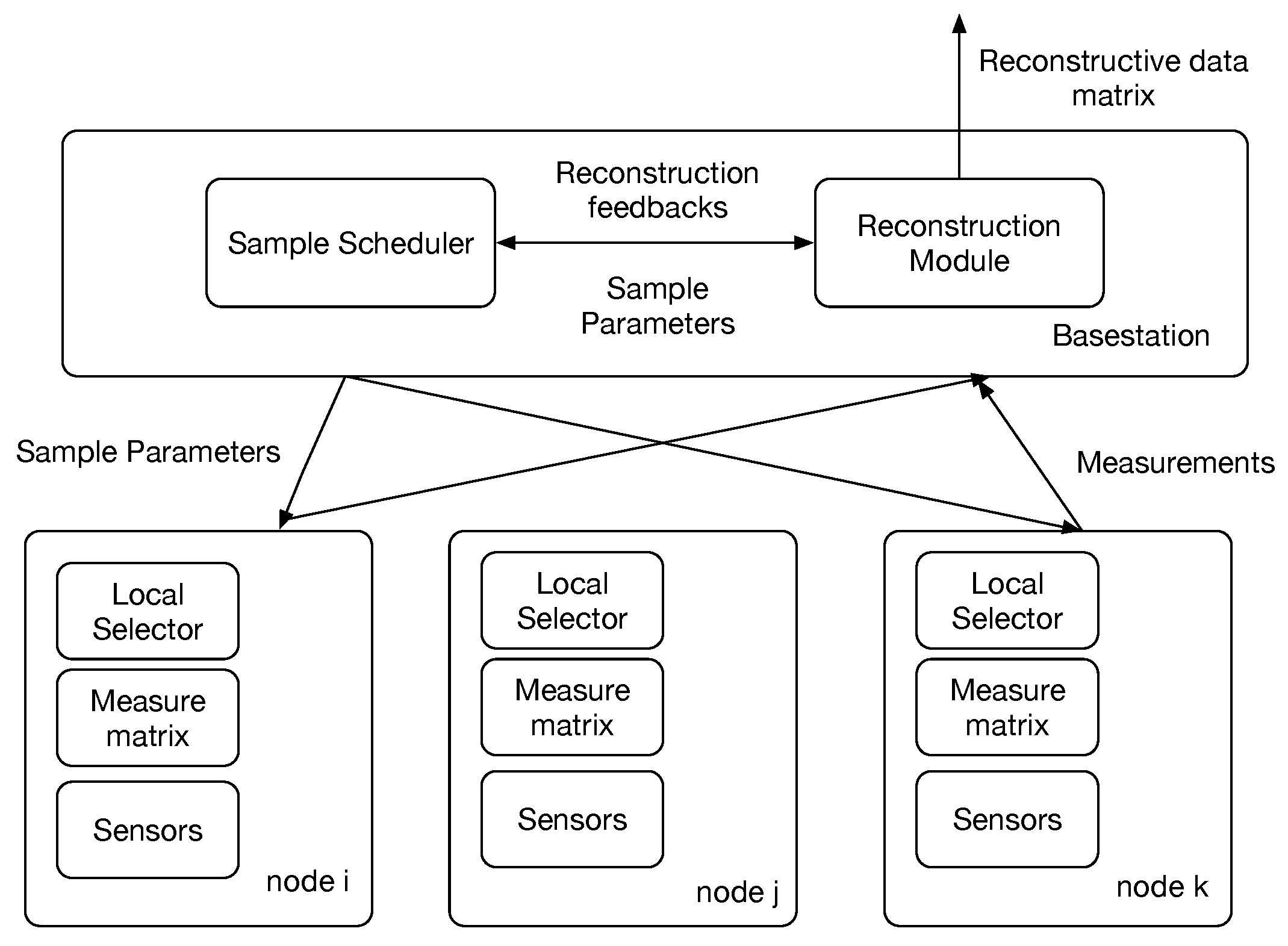
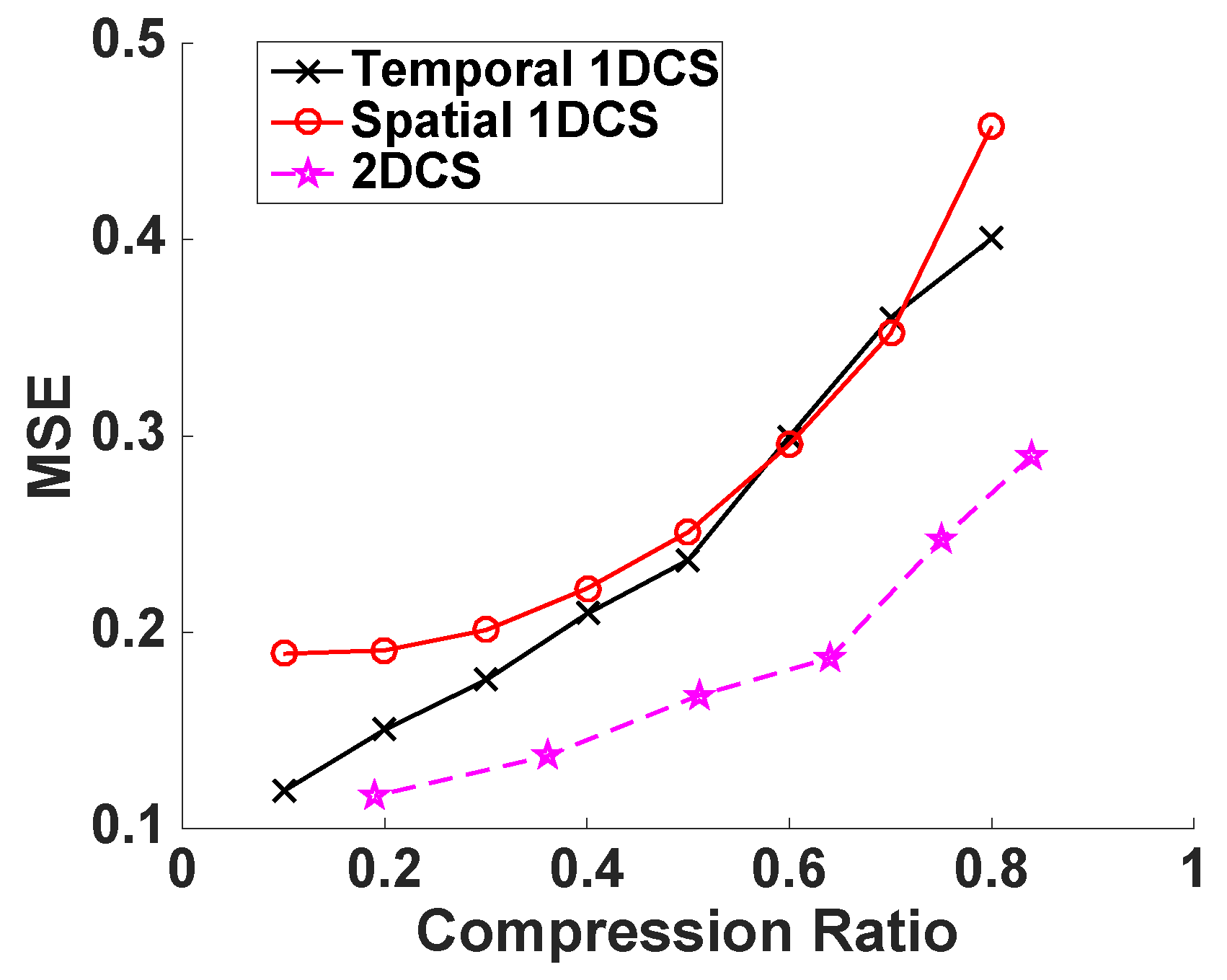

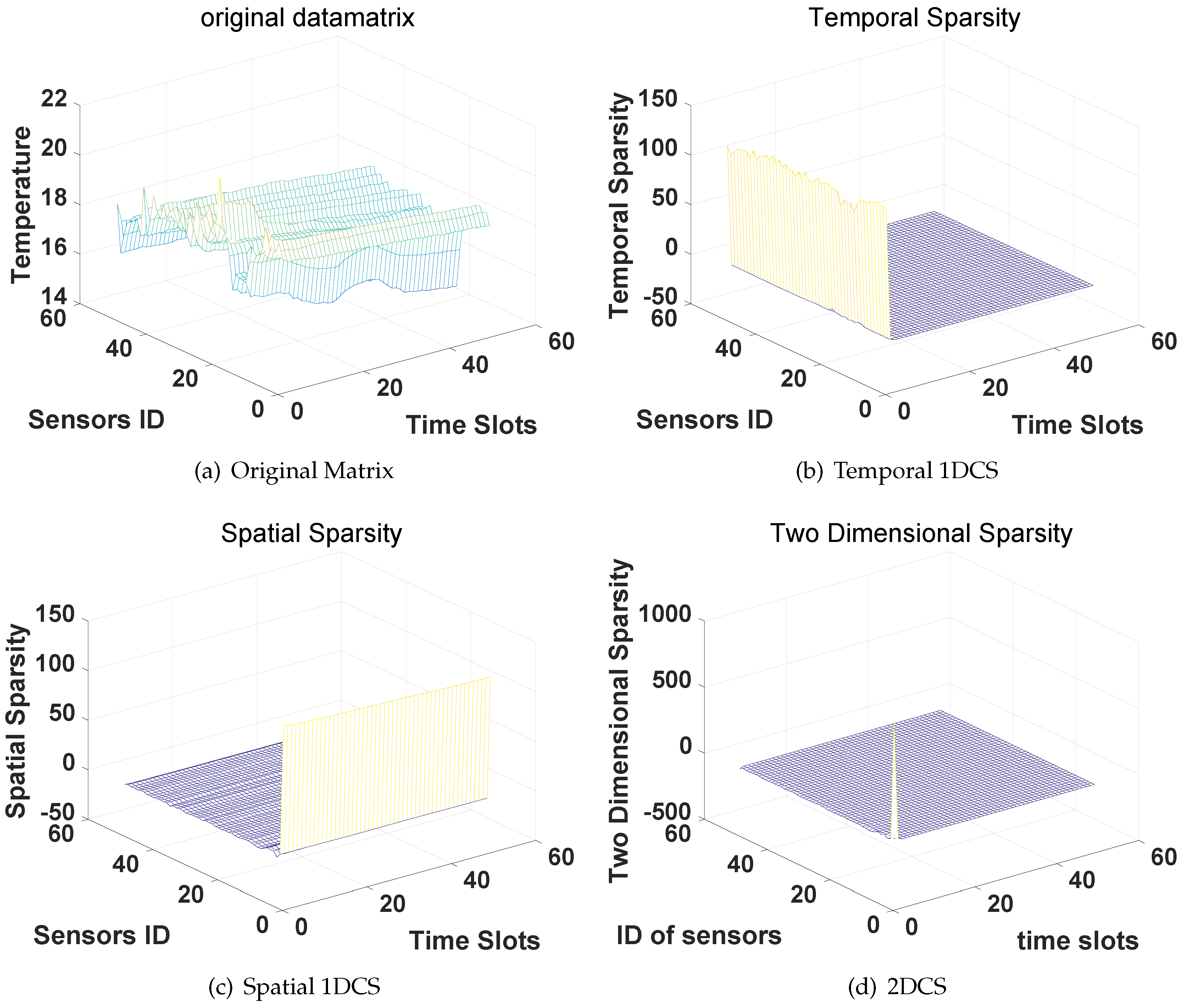
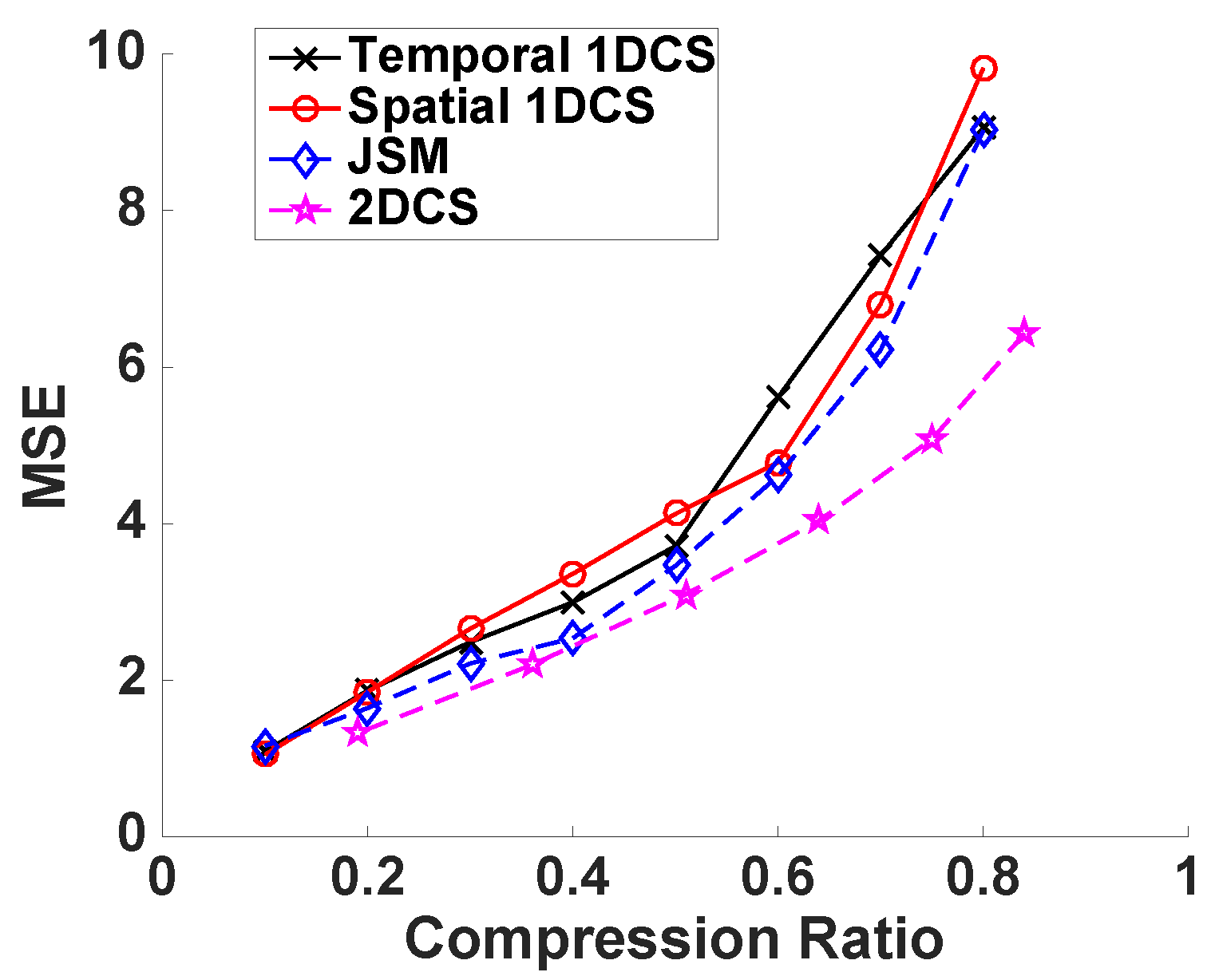
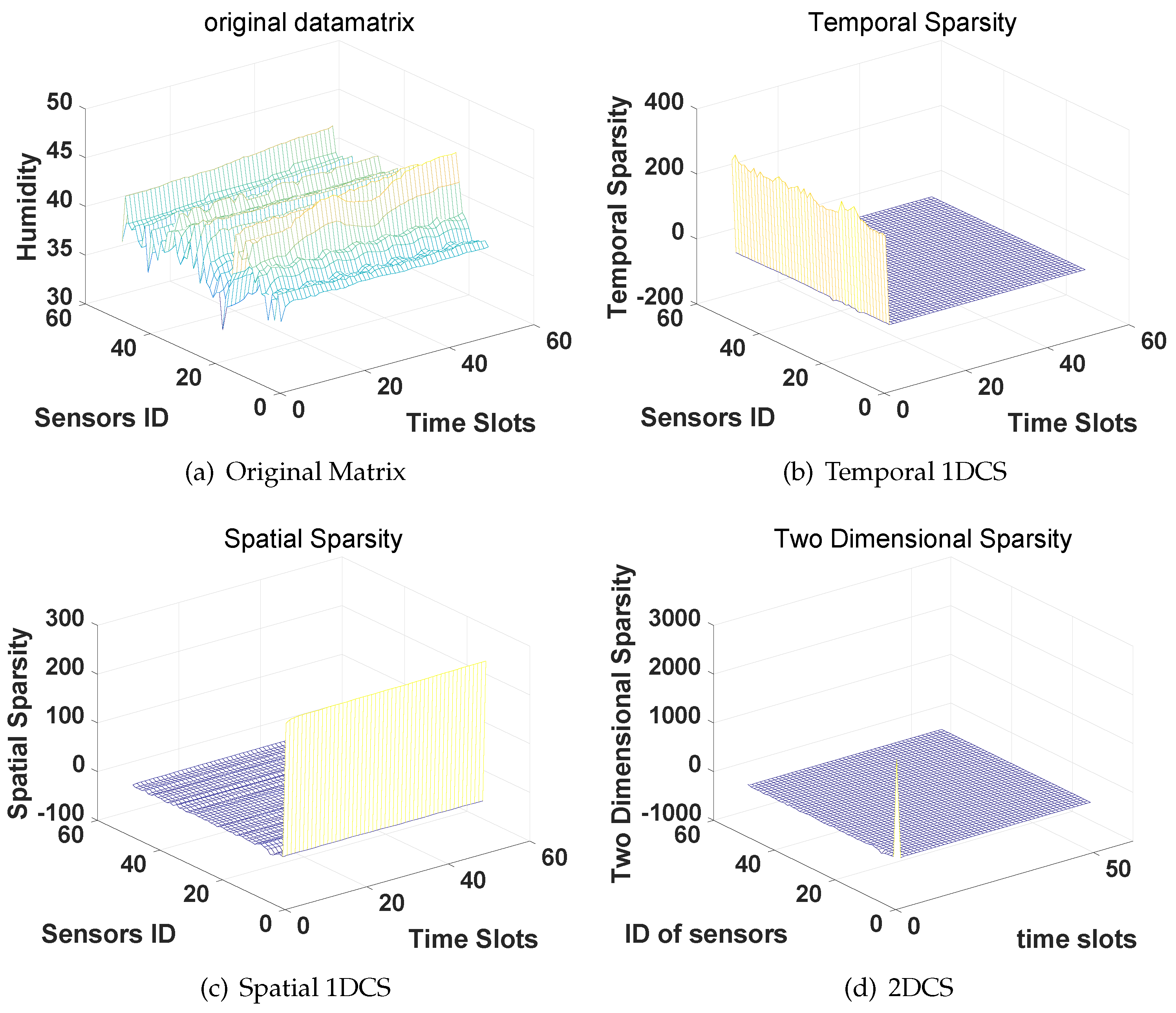
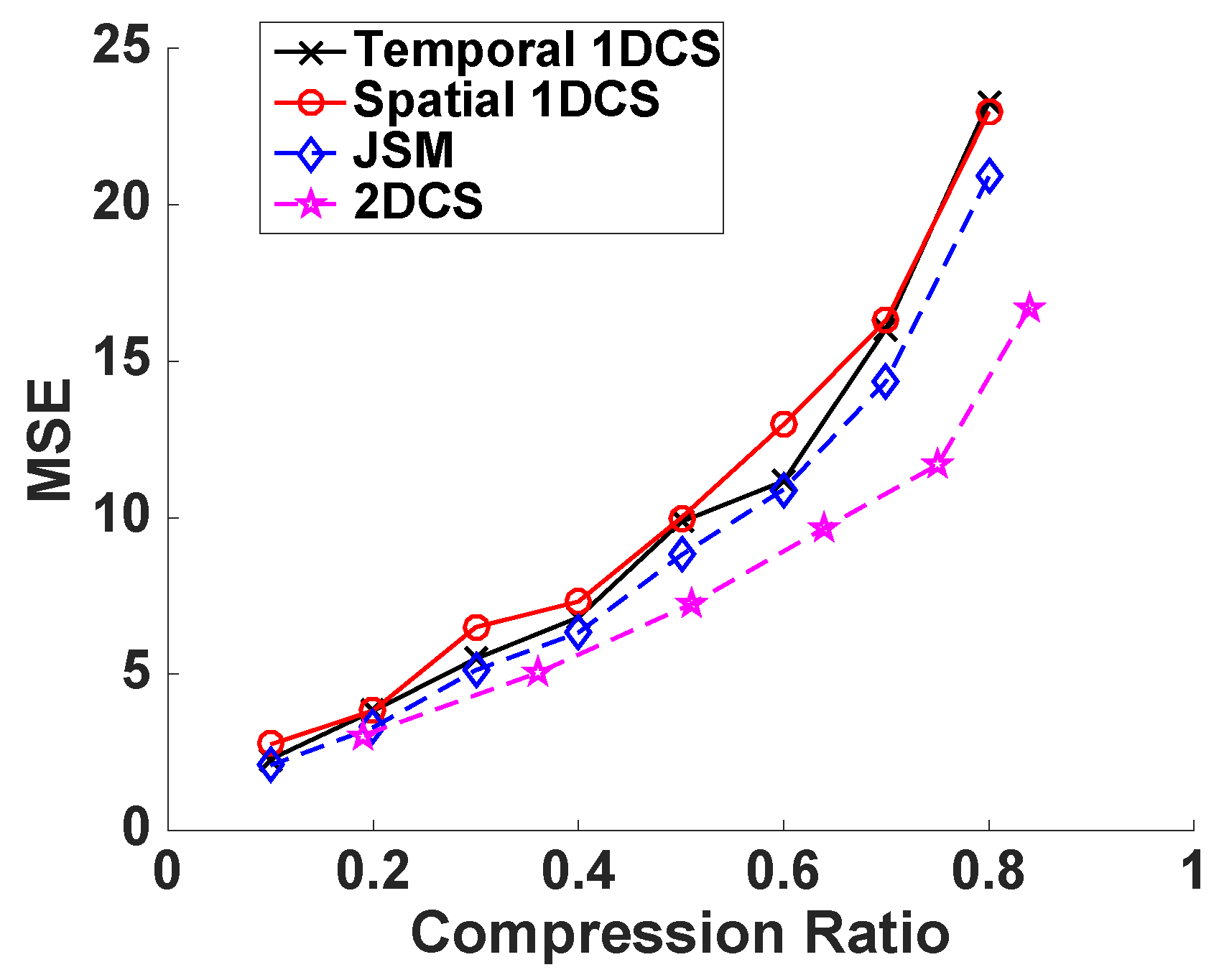
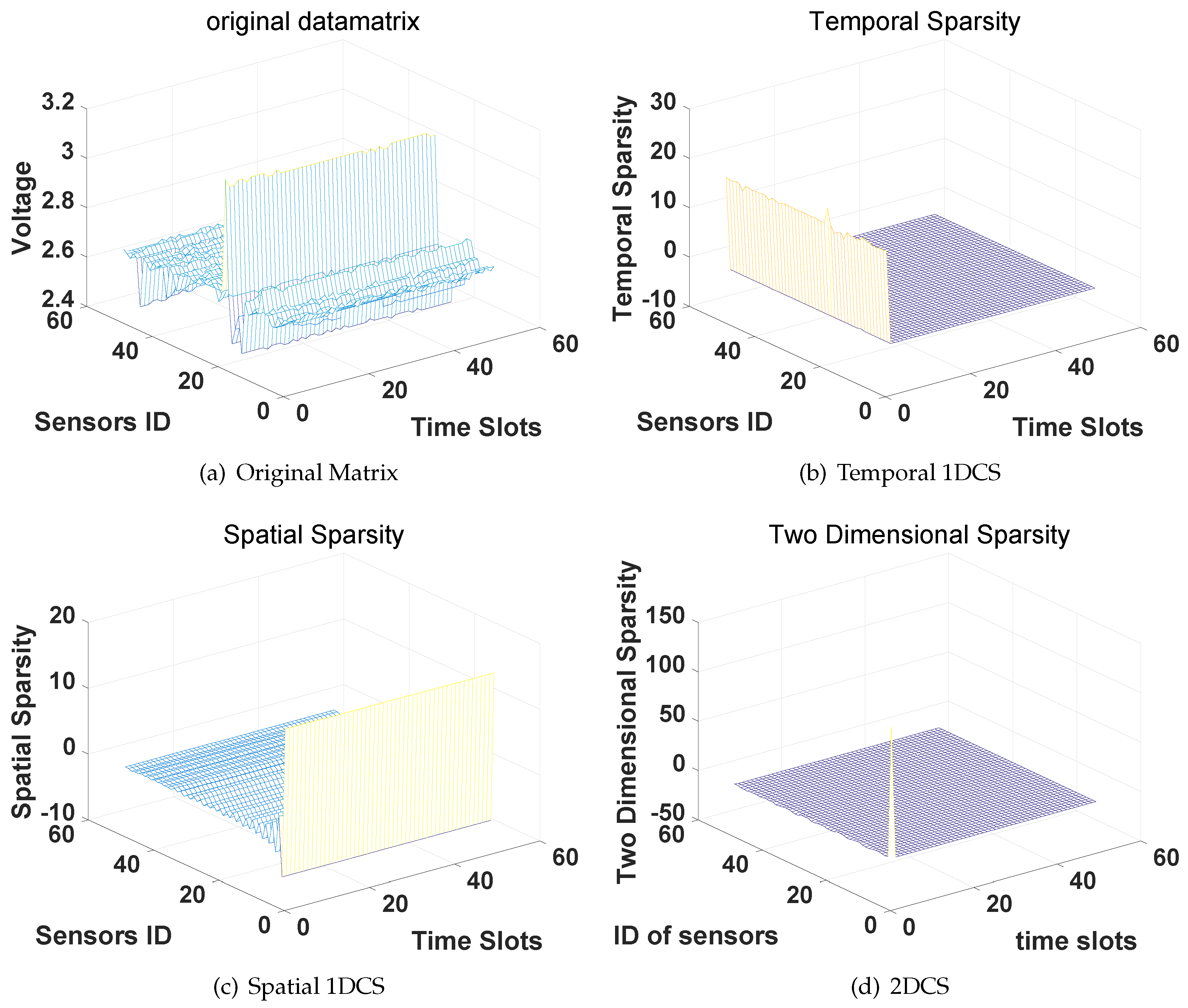
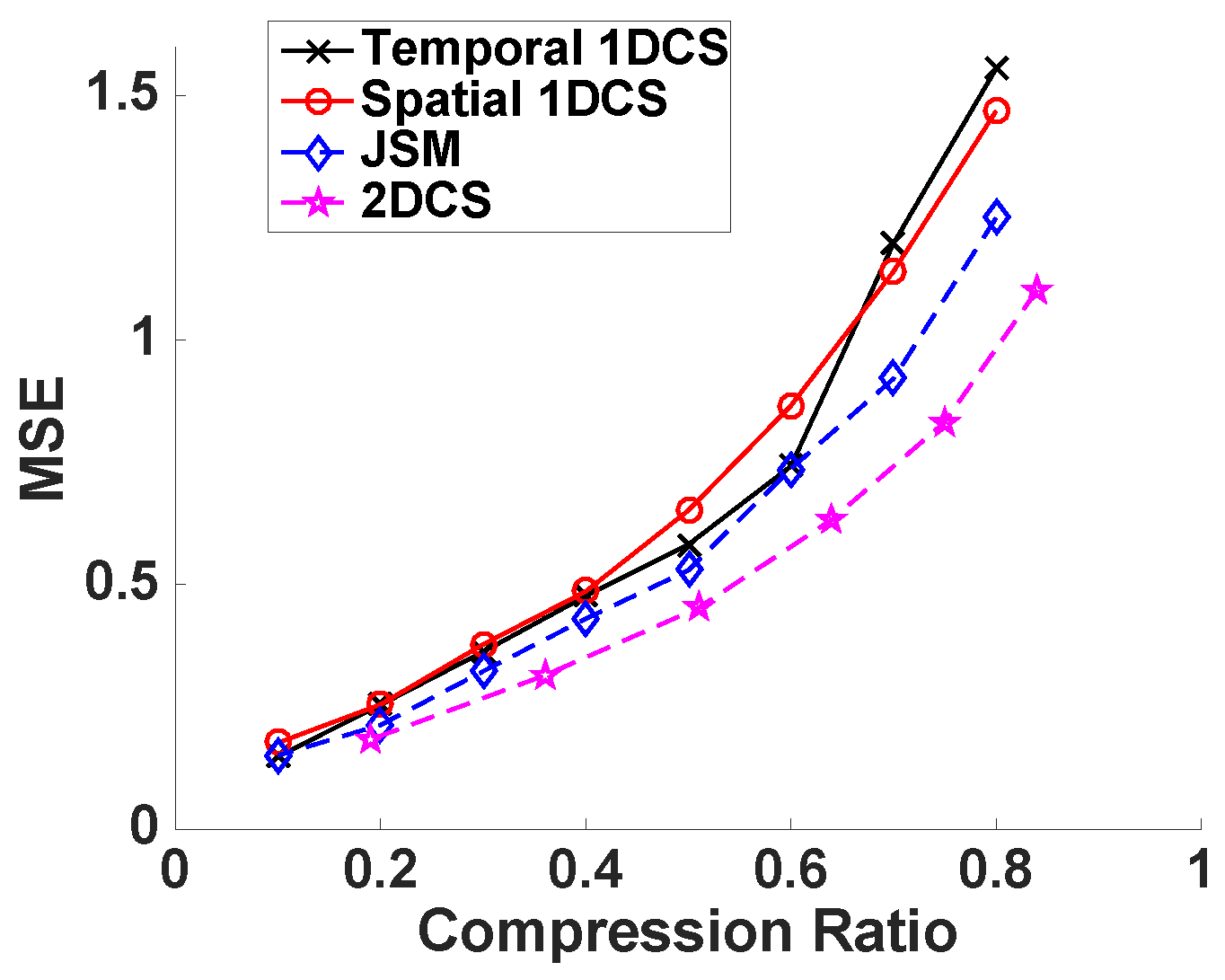

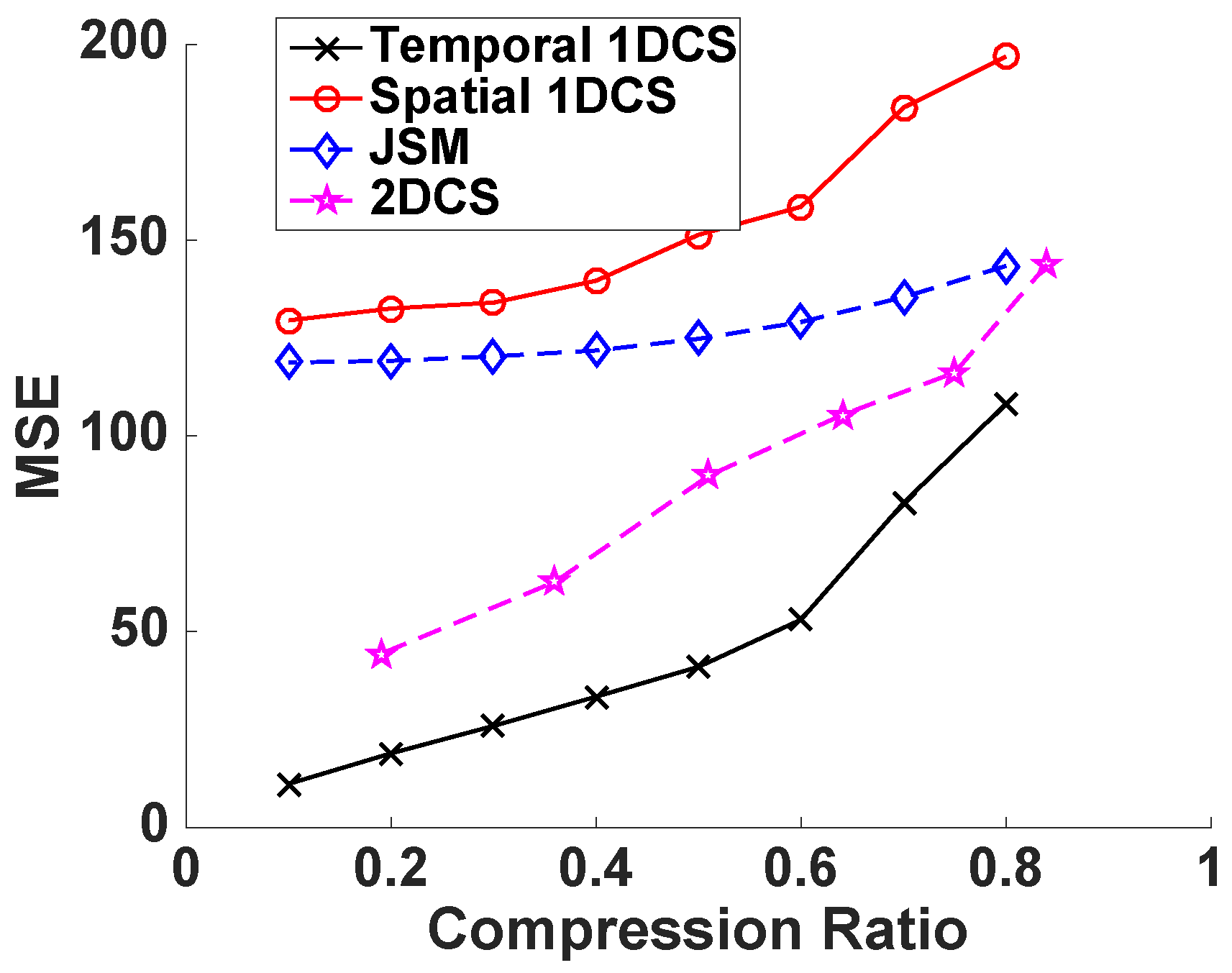
| Device | Duty Cycle | Average Current | The Ratio of Energy |
|---|---|---|---|
| Sensors | 1.67% | 9 (A) | 3.8% |
| Radio | 1% | 206 (A) | 86% |
| Microcontroller | 0.4% | 9.6 (A) | 4% |
| Quiescent | - | 15 (A) | 6.2% |
© 2016 by the authors; licensee MDPI, Basel, Switzerland. This article is an open access article distributed under the terms and conditions of the Creative Commons Attribution (CC-BY) license (http://creativecommons.org/licenses/by/4.0/).
Share and Cite
Wang, Y.; Yang, Z.; Zhang, J.; Li, F.; Wen, H.; Shen, Y. CS2-Collector: A New Approach for Data Collection in Wireless Sensor Networks Based on Two-Dimensional Compressive Sensing. Sensors 2016, 16, 1318. https://doi.org/10.3390/s16081318
Wang Y, Yang Z, Zhang J, Li F, Wen H, Shen Y. CS2-Collector: A New Approach for Data Collection in Wireless Sensor Networks Based on Two-Dimensional Compressive Sensing. Sensors. 2016; 16(8):1318. https://doi.org/10.3390/s16081318
Chicago/Turabian StyleWang, Yong, Zhuoshi Yang, Jianpei Zhang, Feng Li, Hongkai Wen, and Yiran Shen. 2016. "CS2-Collector: A New Approach for Data Collection in Wireless Sensor Networks Based on Two-Dimensional Compressive Sensing" Sensors 16, no. 8: 1318. https://doi.org/10.3390/s16081318






